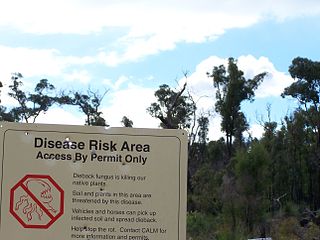
Phytophthora is a genus of plant-damaging oomycetes, whose member species are capable of causing enormous economic losses on crops worldwide, as well as environmental damage in natural ecosystems. The cell wall of Phytophthora is made up of cellulose. The genus was first described by Heinrich Anton de Bary in 1875. Approximately 170 species have been described, although 100–500 undiscovered Phytophthora species are estimated to exist.

Phytophthora cinnamomi is a soil-borne water mould that produces an infection which causes a condition in plants variously called "root rot", "dieback", or, "ink disease". The plant pathogen is one of the world's most invasive species and is present in over 70 countries around the world.

Adenanthos cygnorum, commonly known as common woollybush or just woollybush, is a tall shrub in the family Proteaceae. It is endemic to Western Australia, commonly occurring in the south west of the State from north of Geraldton south to Kojonup. It is very common on road verges and in disturbed areas of Perth.
Chthonocephalus is a genus of annual herbs in the family Asteraceae. The genus is endemic to Australia, with species occurring in all mainland states.
Adenanthos terminalis, commonly known as gland flower, yellow gland flower or adenanthos, is a one metre tall shrub in the family Proteaceae. It is found in south eastern regions of Australia, in the states of South Australia and Victoria, and is the most widespread of the two Adenanthos species occurring outside of Western Australia.

Isopogon ceratophyllus, commonly known as the horny cone-bush or wild Irishman, is a plant of the family Proteaceae that is endemic to the coast in Victoria, South Australia and on the Furneaux Group of islands in Tasmania. It is a small woody shrub that grows to 100 cm high with prickly foliage. It is extremely sensitive to dieback from the pathogen Phytophthora cinnamomi

Pogonolepis is a genus of Australian plants in the tribe Gnaphalieae (pussy's-toes) within the daisy family Asteraceae.

{{taxobox |image = Asteridea pulverulenta - Flickr - Kevin Thiele.jpg |image_caption = Asteridea pulverulenta |regnum = Plantae |unranked_divisio = Angiosperms |tribus=Gnaphalieae |unranked_classis = Eudicots |unranked_ordo = Asterids |ordo = Asterales |familia = Asteraceae |genus = Asteridea |genus_authority = Lindl. |type_species = Asteridea pulverulenta |type_species_authority = Lindl. }} Asteridea is a genus of flowering plants in the daisy family. Evidence suggests that the genus, Asteridea, is monophyletic.

Adenanthos detmoldii, commonly known as Scott River jugflower or yellow jugflower, is a species of shrub in the family Proteaceae. It is endemic to the south-west of Western Australia.
Adenanthos ileticos is a species of shrub in the family Proteaceae. It has roughly triangular, lobed leaves, and pale pink-red and cream, inconspicuous flowers. A rare species, it is known only from a single location in the south-west of Western Australia. It was discovered in 1968, and immediately brought into cultivation, but it would not be formally published and named until a decade later.

Adenanthos barbiger, the hairy jugflower or hairy glandflower, is a species of shrub in the family Proteaceae. It is endemic to the south-west of Western Australia. It usually grows to 1 metre high, and has bright red flowers that appear mostly between August and December. The species was first formally described in 1839 by English botanist John Lindley in A sketch of the vegetation of the Swan River colony.

Adenanthos meisneri, commonly known as prostrate woollybush, is a species of shrub in the family Proteaceae. It is endemic to the south-west of Western Australia.

Adenanthos pungens, the spiky adenanthos, is a species of shrub in the family Proteaceae. It is endemic to the south-west of Western Australia.

Adenanthos × cunninghamii, commonly known as woollybush, Albany woollybush or prostrate woollybush, is a hybrid shrub in the family Proteaceae. It is endemic to the south-west of Western Australia.
Adenanthos dobagii, commonly known as Fitzgerald woollybush, is a shrub in the family Proteaceae. It grows to a mere 50 cm high, with crowded small silvery leaves and insignificant pink or cream flowers. It occurs only in southwestern Australia, where it is found in Fitzgerald River National Park on the south coast.

Isopogon latifolius is a shrub of the family Proteaceae that is endemic to the southwest botanical province of Western Australia.

Persoonia muelleri, commonly known as Mueller’s geebung, is a shrub endemic to Tasmania. It forms a shrub in open areas of wet forests in the west and northeast of the state. It is occasionally confused with P. gunnii though it has larger flowers and longer, straighter leaves.

Agastachys odorata, commonly known as the white waratah, is the sole member of the genus Agastachys in the protea family. It is an evergreen shrub to small tree and is endemic to the heaths and button grass sedgelands of western Tasmania. It occurs most often in moist heath and scrub and occasionally in the alpine regions, but generally prefers well-drained but poor soils. It can grow in some rainforests where it forms a small tree but is normally a shrub in all other situations. The heaviest concentrations are along the island's south coast. Its leaves are dark green, hairless and almost succulent. Masses of white flowers are produced in erect spikes from the ends of the branches. Measuring 8 to 12 cm high, they appear in January and February.

Argentipallium niveum is a species of plant within the genus, Argentipallium, in the daisy family (Asteraceae). It is endemic to Western Australia.

Pogonolepis stricta is a species of daisy (Asteraceae), which is endemic to Western Australia. It was first described by Joachim Steetz in 1845.















